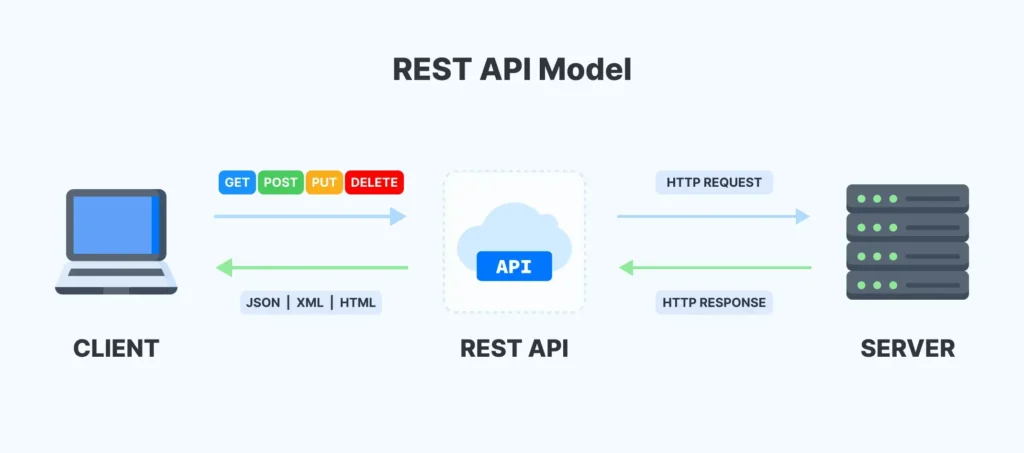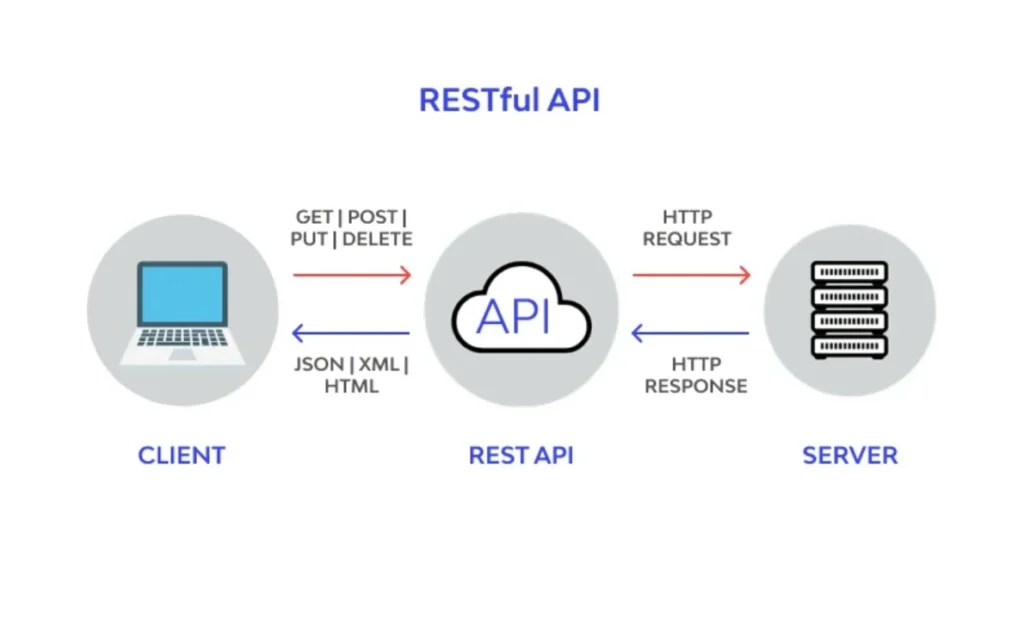In today’s world, integration is key, and the ability to exchange data between systems has never been more crucial. Take Uber, for instance—it must pull location data from Google Maps and process payments through PayPal. APIs, or Application Programming Interfaces, allow these applications to communicate with each other.
When building APIs, two primary approaches stand out for enabling software interaction in your project: REST APIs and RESTful APIs.
While the difference between API and REST API might take time to be clear, developers often discuss it during software architecture conversations and important project decisions.
To put it simply, the distinction isn’t as big as it may seem. Although people often use the terms interchangeably, they serve slightly different purposes. REST defines a set of design constraints, while RESTful refers to an API that follows those constraints. Both serve web services and applications well.
In other words, REST is an architectural style, and RESTful refers to web services that implement this style.
So, can you use the terms interchangeably? In some cases, yes. But it’s not as straightforward as it seems. It’s not simply a matter of “REST” being a noun and “RESTful” being an adjective. This blog post will help clear up the confusion between REST and RESTful API, explaining how they work and how to use them effectively in your development projects.
What is a REST API?
A REST API uses HTTP requests to access and exchange data securely over the internet. It allows two computer systems to communicate.

An API is essentially a set of rules created on the server side to enable communication between programs. REST defines how an API should be structured and how developers should implement it.
REST APIs work similarly to how you get results when searching for something online. The concept was introduced by Roy Fielding in 2000 and has since become a core practice in modern software engineering.
Key principles of REST APIs include:
- Layered system: Components can only interact within their designated layer. This improves scalability and allows easier addition of proxies and load balancers.
- Uniform interface: The most important feature of REST is the consistency in the interfaces between all components.
- Cacheability: Servers identify whether responses are cacheable or not. This allows for the caching of necessary data, improving performance.
- Statelessness: In REST, clients maintain the application state, but servers do not. Each request from a client must include all the necessary information for processing.
What is a RESTful API?
A RESTful API allows two systems to exchange information securely over the internet. It provides a simple and scalable way to build APIs that work across different programming languages and platforms.
These APIs are widely used. The goal of REST was to standardize the web. Most APIs you work with or build will follow RESTful principles.
RESTful APIs follow the constraints of the REST architecture. This makes them scalable, fast, and able to handle all types of data. They use HTTP requests to access data and are common in web development.
Key components of RESTful APIs include:
- Headers: Manage connection types, proxies, and metadata for requests and responses.
- Data: The body of the request contains the client’s requested resource. The header determines the content type, and the body holds the data.
- Method: RESTful APIs use HTTP methods like GET, POST, or DELETE to manipulate data.
- Endpoints: URLs that define the data location on the server. These are the resources accessed via the API.
RESTful APIs are efficient, use less bandwidth, support various data formats, and are easy to learn. Developers don’t need to build them from scratch. They are commonly used in SaaS applications and are suitable for both public and private use.
Key Differences Between REST and RESTful APIs
While REST API and RESTful API both enable communication between systems, they have some notable differences.
1. URL and Application Dependency
- REST API: Works based on a simple request and response model, where URLs handle specific requests.
- RESTful API: Fully depends on REST architecture to function.
2. Purpose and Interoperability
- REST API: Used for communication between client and server.
- RESTful API: Follows REST principles to ensure interoperability across different systems.
3. Basis of Operation
- REST API: Operates based on the request-response model.
- RESTful API: Adheres to REST architecture principles.
4. Security Protocols
- REST API: Uses strong security protocols and pre-set architecture layers.
- RESTful API: Employs multi-layered protocols but might be slightly less secure.
5. Data Format
- REST API: Primarily uses HTTP for data formatting.
- RESTful API: Supports multiple formats, including HTTP, Text, and JSON.
6. Bandwidth Consumption
- REST API: Consumes minimal bandwidth.
- RESTful API: Designed for even more efficient bandwidth usage.
7. Architectural Patterns
- REST API: No strict architectural pattern.
- RESTful API: Commonly follows the Model View Controller (MVC) pattern for cleaner code.
8. Flexibility and Adaptability
- REST API: Highly flexible and adaptable for different development approaches.
- RESTful API: More versatile with extensive flexibility.
9. Resources and Endpoints
- REST API: Endpoints may not always represent resources.
- RESTful API: Endpoints always represent resources, ensuring uniformity.
10. Statelessness
- REST API: Responses may not always be cacheable.
- RESTful API: Maintains statelessness for better performance and reliability.
11. Cacheability
- REST API: Explicitly marks responses as cacheable.
- RESTful API: Cacheability depends on the endpoint, offering more flexibility.
12. Uniform Interface
- REST API: Interface may vary between endpoints.
- RESTful API: Provides a uniform interface across all resources.
13. Client-Server Architecture
- REST API: May mix client and server code.
- RESTful API: Keeps client and server code separate.
14. Layered System
- REST API: Can bypass intermediate servers.
- RESTful API: Always follows a layered architecture.
REST vs RESTful: A Quick Comparison
Here’s a side-by-side look at the differences:
While REST API and RESTful API both enable communication between systems, they have some notable differences.
Feature | REST API | RESTful API |
Definition | Partially follows REST principles | Follows REST principles strictly |
Structure | May vary in consistency | Strict and predictable |
Resource Management | Flexible but potentially less predictable | Consistent with well-defined endpoint behavior |
Ideal For | Quick prototypes or fast development | Scalable and stable applications |
For entrepreneurs and startups, a REST API might offer a quicker route to launch. For projects that need long-term stability, a RESTful API’s structured approach is beneficial.
Key Takeaways
In the end, the choice between REST APIs and RESTful APIs depends on key factors. Developers should carefully consider scalability, flexibility, ease of use, and compatibility with front-end frameworks. These elements will help guide your decision, based on the specific needs of your project.
Additionally, it’s essential to consider the project’s requirements, the development team’s experience, and long-term maintenance. By doing so, you can ensure a balanced decision-making process.
Furthermore, both REST and RESTful APIs offer distinct advantages. However, the right choice ultimately depends on your project goals and your team’s skills.
Finally, if you’re ready to choose the right API solution for your web app, partnering with Code Genesis for API development might just be the best decision for your project.